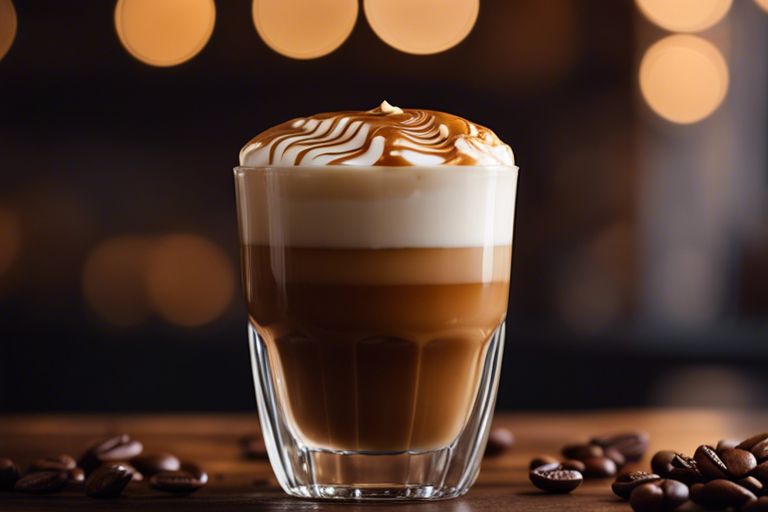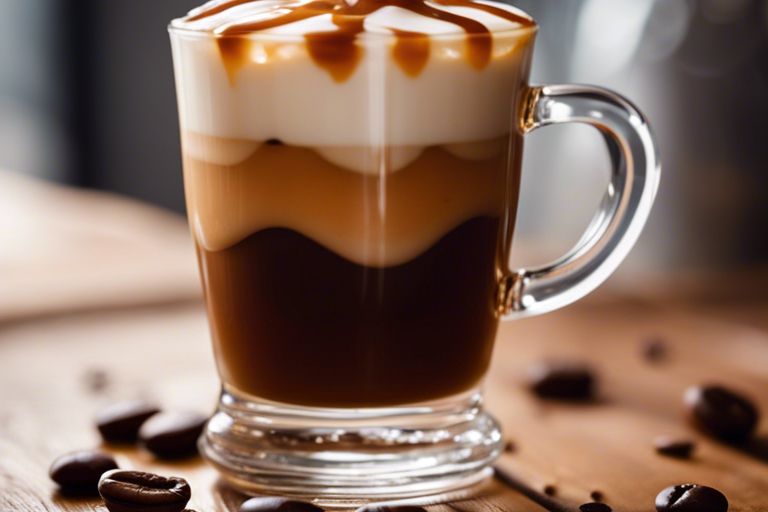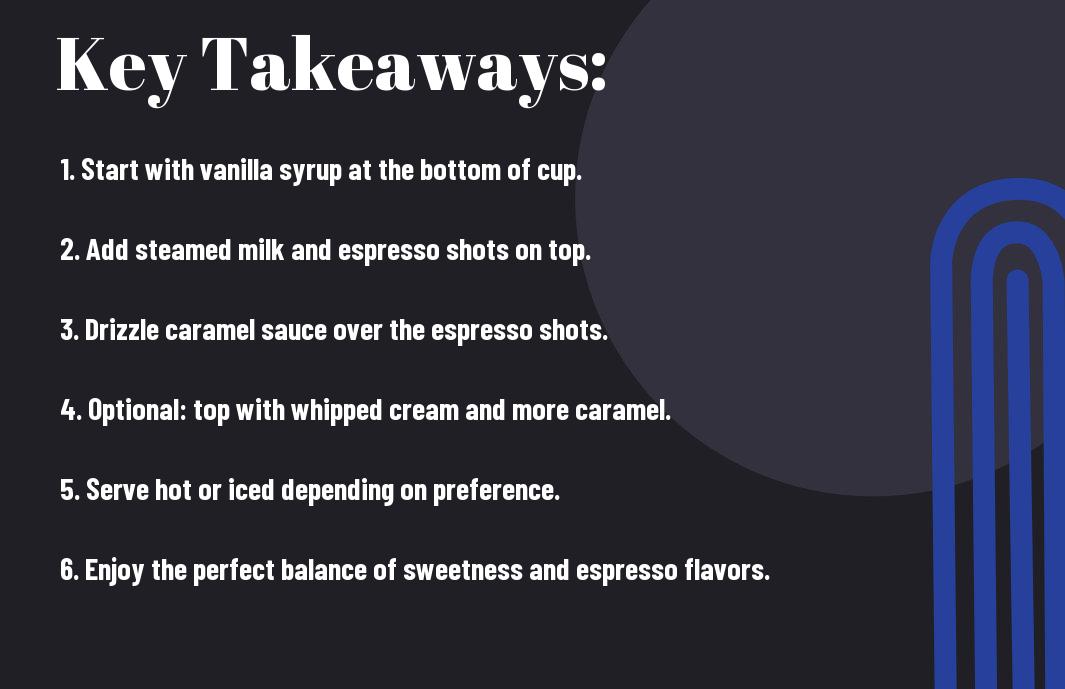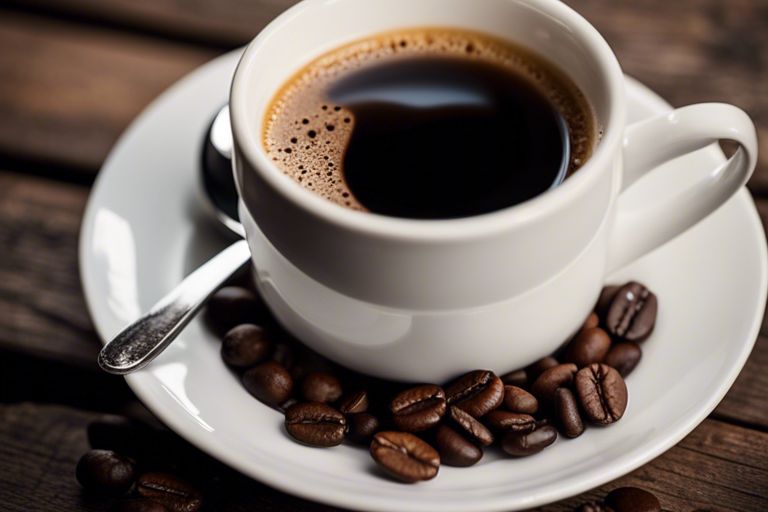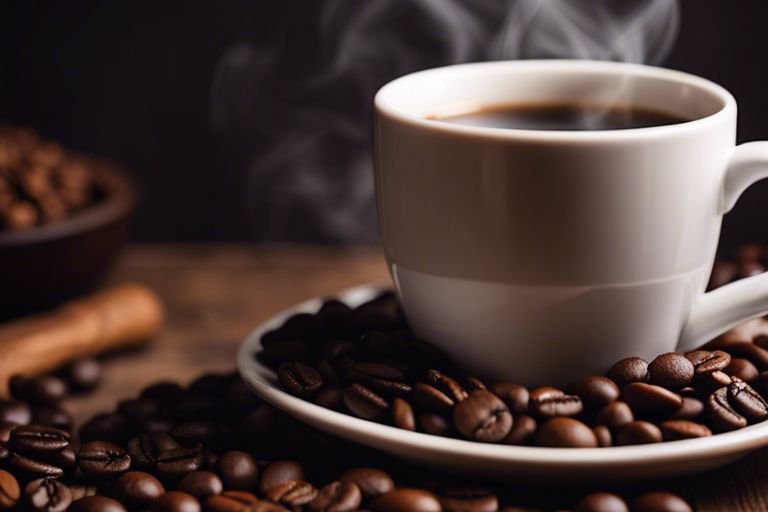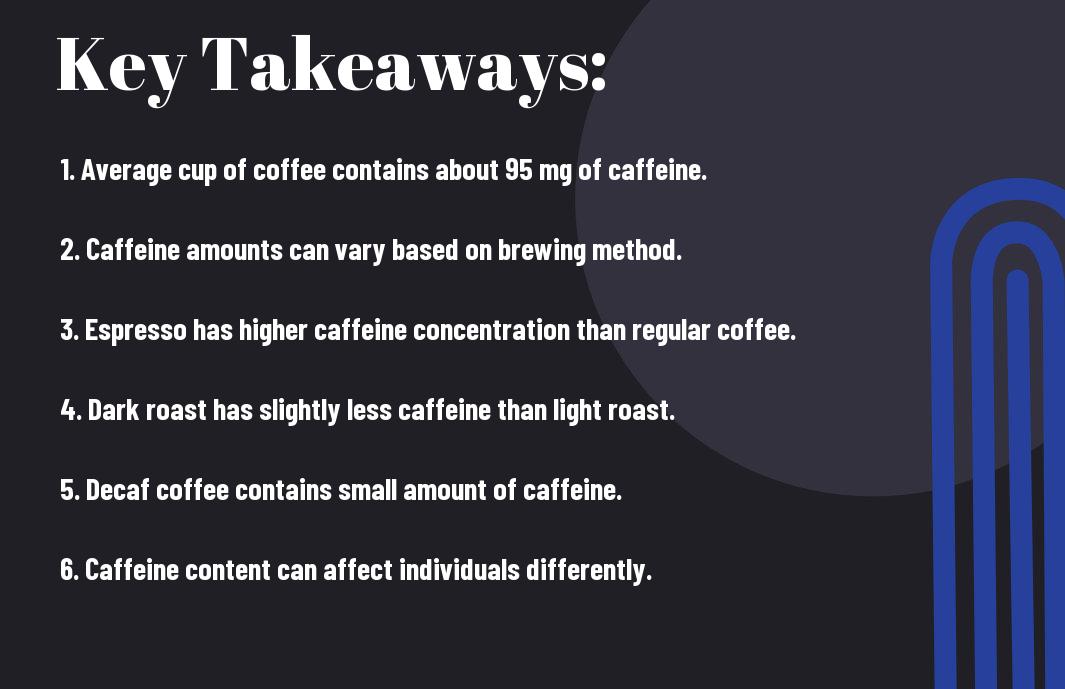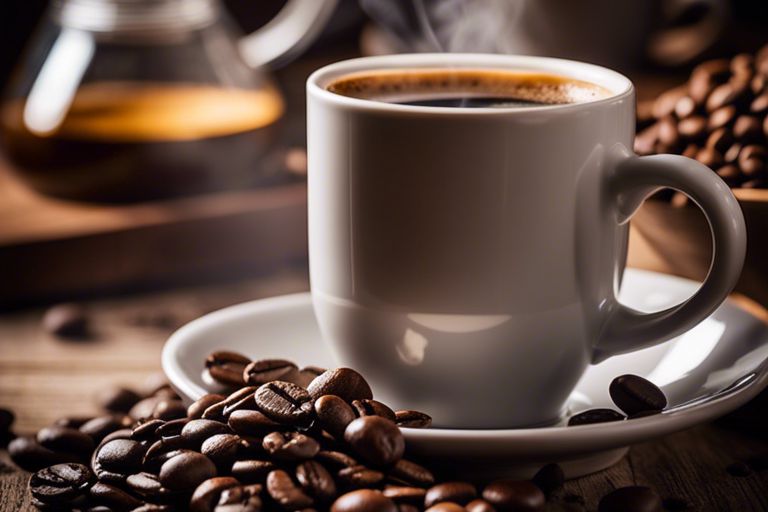#Beverage enthusiasts often ponder the question, what is a macchiato? A macchiato, meaning “stained” or “spotted” in Italian, is a coffee drink that combines espresso with a splash of milk. To uncover more about this intriguing beverage and its variations, investigate into the article on What is a Macchiato? (Difference Between Types of ….

Key Takeaways:
- Origin: A macchiato is an espresso-based coffee originating from Italy.
- Preparation: It consists of a shot of espresso “stained” with a small amount of steamed milk or milk foam.
- Flavor: Macchiatos have a bold and strong coffee flavor with a slight hint of milk.
- Variations: There are different versions of macchiatos, such as the traditional macchiato, caramel macchiato, and latte macchiato.
- Serving: Macchiatos are typically served in small espresso cups and consumed quickly to enjoy the flavors at their best.
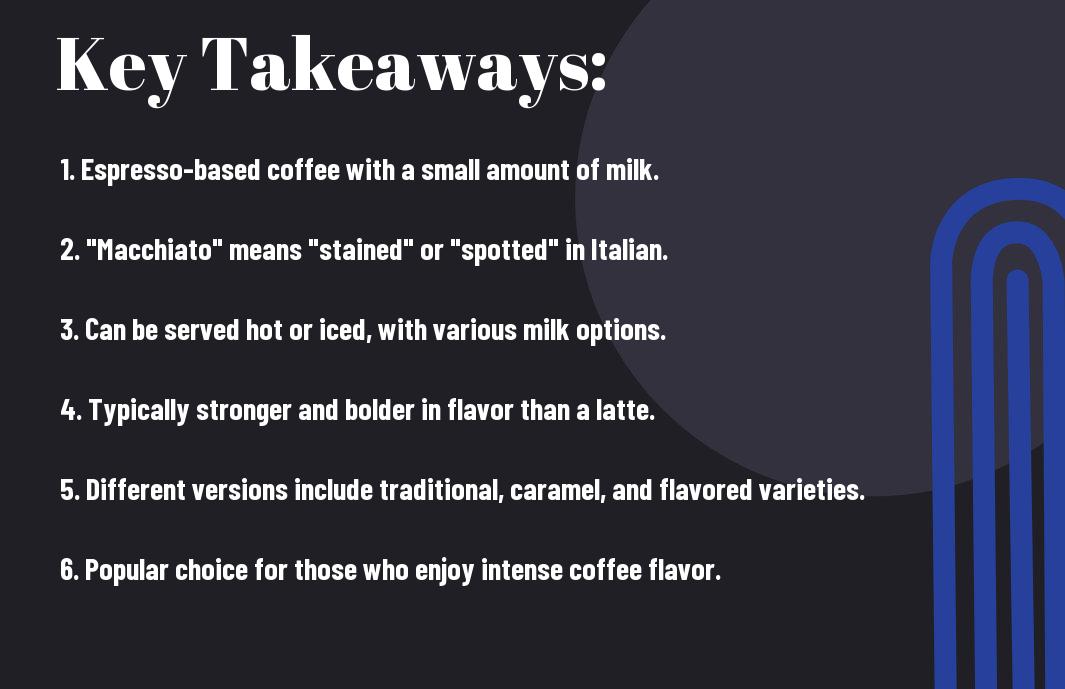
Origins
Before stepping into what a macchiato is today, it’s crucial to understand its origins. This espresso-based drink has a rich history that traces back to Italy, the birthplace of espresso culture.
Italian Roots
Roots of the macchiato can be found in Italian coffee traditions. “Macchiato” in Italian means “stained” or “spotted,” referring to the hallmark dot of milk that distinguishes this beverage. In Italy, the macchiato is enjoyed as a way to savor the bold flavor of espresso with just a hint of milk, unlike the milky lattes or cappuccinos often associated with coffee culture in other parts of the world.
The Name “Macchiato”
To understand the significance of the name “macchiato,” it’s important to recognize how this term reflects the drink itself. The “staining” of the espresso with milk adds a touch of creaminess and sweetness, balancing the intensity of the coffee without overwhelming its robust flavor. This minimalist approach to coffee preparation is a hallmark of Italian coffee culture, where simplicity and quality reign supreme.
For instance, in Italy, ordering a “macchiato” may not even specify the type of macchiato desired, as the default is often a traditional macchiato with just a dollop of frothy milk. This showcases the elegance of Italian coffee culture, where less is often more when it comes to enjoying a perfectly crafted cup.
Definition
A Shot of Espresso
Now, let’s break down the components of a macchiato. The first and most important element of a macchiato is a shot of espresso. This is a concentrated coffee brewed by forcing a small amount of nearly boiling water through finely-ground coffee beans. The result is a strong and robust coffee flavor that forms the base of the macchiato.
A Dash of Milk
With a macchiato, a dash of milk is added to the espresso. This touch of milk is what sets a macchiato apart from other espresso-based drinks like a cappuccino or latte. The milk is steamed and added in a small amount to slightly soften the intensity of the espresso, creating a balanced and flavorful beverage.
Plus, the term “macchiato” actually means “stained” or “spotted” in Italian. This refers to the way the milk is added to the espresso, creating a coffee drink that is marked or stained with a small amount of milk. This delicate balance of espresso and milk is what makes a macchiato a beloved choice for coffee enthusiasts looking for a simple yet satisfying drink.
Types of Macchiatos
Keep reading to discover the different types of macchiatos and how they differ from each other.
- Traditional Macchiato
- Long Macchiato
- Short Macchiato
- Caramel Macchiato
- Coconut Milk Macchiato
After exploring these variations, you’ll have a better understanding of the delightful world of macchiatos.
Traditional Macchiato
| Any | fan of espresso will appreciate the simplicity of a traditional macchiato. |
| This | espresso-based drink consists of a shot of espresso “marked” with a small amount of steamed milk, creating a bold and intense flavor profile. |
Long Macchiato
Types of macchiatos. A long macchiato is a variation of traditional macchiato where more steamed milk is added to the espresso, resulting in a milder taste compared to the original version.
Short Macchiato
The short macchiato is the opposite of the long macchiato, consisting of a higher ratio of espresso to steamed milk. The result is a stronger coffee flavor with just a hint of milk to balance the intensity.
The short macchiato is perfect for those who prefer a more robust coffee experience but still enjoy a touch of creaminess in their drink.
Preparation
Pulling the Perfect Shot
Preparation is key when making a macchiato. Many baristas start by pulling the perfect shot of espresso. This involves grinding the coffee beans to the right consistency, tamping them down firmly in the portafilter, and ensuring that the espresso machine is at the correct temperature and pressure. The goal is to extract a rich, flavorful shot of espresso with a layer of crema on top.
Steaming the Milk
Milk plays a crucial role in a macchiato, adding a creamy texture and taste to the espresso. To steam the milk, baristas heat it using a steam wand until it reaches the ideal temperature and creates velvety microfoam. This step requires precision and attention to detail to achieve the perfect consistency for pouring into the espresso.
Understanding the importance of properly steaming the milk is necessary in creating a well-balanced macchiato. The process involves aerating the milk to create a creamy texture that complements the bold flavor of the espresso. Baristas must pay close attention to the temperature and texture of the milk to achieve the desired result.
Combining the Two
Combining the espresso and steamed milk is the final step in making a macchiato. This process requires skill and precision to achieve the classic layered look of a macchiato. Baristas carefully pour the steamed milk on top of the espresso, creating a beautiful contrast of colors and flavors in the glass.
With a few simple steps and the right technique, anyone can enjoy a delicious macchiato made just like a professional barista.

Serving Suggestions
Traditional Serving Style
An authentic macchiato is traditionally served in a small espresso cup, showcasing the rich, intense flavors of the espresso with just a hint of milk. The milk is typically steamed and frothed, then carefully spooned onto the top of the espresso, creating a beautiful layered look. This classic presentation allows you to savor the bold coffee taste, balanced by the creamy touch of milk.
Modern Twists
Style has evolved, and modern coffee shops have put innovative spins on the traditional macchiato. You might find variations like flavored syrups, caramel drizzle, or even different types of milk like almond or oat milk used to create unique and flavorful macchiatos. Some coffee aficionados even experiment with serving the macchiato over ice, turning it into a refreshing cold beverage perfect for warmer days.
The possibilities are endless when it comes to modern twists on the macchiato. Whether you prefer a classic preparation or enjoy exploring new flavor combinations, there’s a macchiato style out there to suit your taste preferences.
Cultural Significance
Once again, the macchiato holds cultural significance beyond its ingredients and preparation. In Italy, where coffee is a way of life, the macchiato is not just a drink but a symbol of a social ritual. It is often enjoyed as a mid-morning pick-me-up or as a brief respite during a busy day.
Italian Coffee Culture
Any discussion of the macchiato’s cultural significance must touch upon Italian coffee culture. In Italy, coffee is more than just a beverage; it is a daily ritual steeped in tradition and social interactions. The macchiato, with its perfect balance of espresso and milk, embodies this cultural reverence for coffee.
Global Popularity
Significance: The macchiato’s popularity has transcended Italian borders, becoming a beloved coffee option worldwide. Its versatility and strong flavor profile have made it a favorite among coffee enthusiasts everywhere.
Plus, the macchiato’s small size and potent taste make it a favorite among busy professionals and coffee drinkers on the go. Its quick consumption and caffeine kick have solidified its place in the global coffee culture.
To wrap up
Presently, understanding what a macchiato is doesn’t have to be a complicated matter. Whether you prefer the traditional espresso macchiato or the more modern versions like the caramel macchiato, this coffee beverage offers a simple yet delightful way to enjoy the rich flavors of espresso with a hint of milk. So next time you order a macchiato, savor its bold taste and appreciate the artistry behind this classic coffee creation.
FAQ
Q: What is a macchiato?
A: A macchiato is a type of coffee that consists of a shot of espresso with a small amount of steamed milk added, creating a “stained” or “spotted” appearance.
Q: How is a macchiato different from other coffee drinks?
A: Unlike a latte or cappuccino which have more milk added, a macchiato has just a small amount of milk, allowing the bold flavor of the espresso to shine through.
Q: What are the different types of macchiatos?
A: There are two main types of macchiatos – the traditional espresso macchiato which is espresso with a dollop of milk foam on top, and the latte macchiato which is steamed milk “stained” with a shot of espresso.
Q: How should a macchiato be served?
A: A macchiato is typically served in a small espresso cup or a glass, showcasing the layers of espresso and milk for visual appeal.
Q: What is the best time to enjoy a macchiato?
A: A macchiato is perfect for those who enjoy a strong coffee flavor with just a hint of milk, making it an ideal choice for a quick pick-me-up in the morning or as a delightful afternoon treat.
What are the origins of coffee
How much caffeine is in a cup of coffee
Unlocking the Mystique – Exploring the Rich Flavor Profile of Black Coffee










